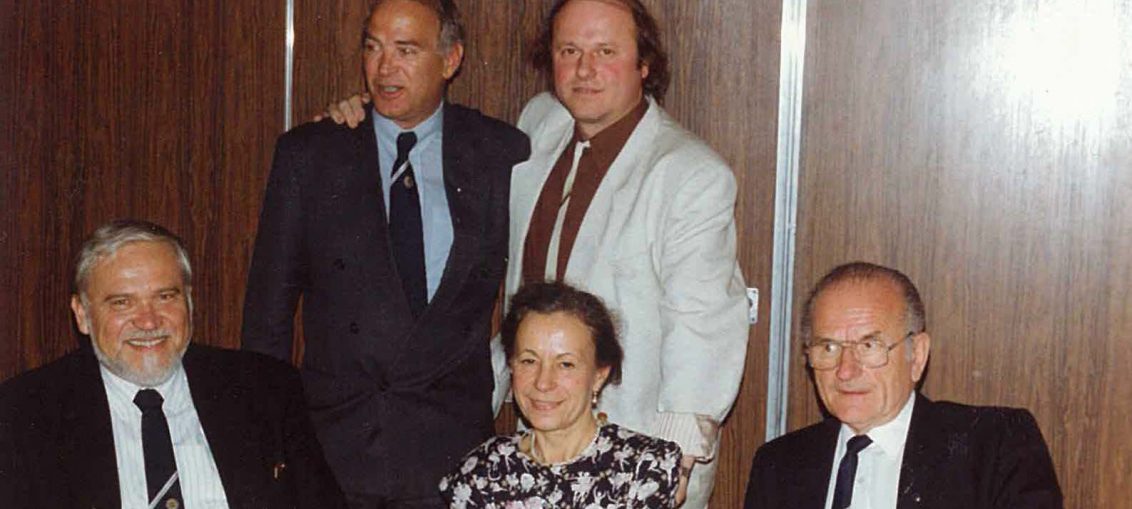
by Anton Lehmann
The well-known and popular table tennis coach, Laszlo Pal, passed away on Sunday 10th October 2021. He was 85 years old.
One year ago, I met him on two occasions.
Alongside other young people, it is now over 60 years since Laszlo Pal took me under his wing. He was always positive and had an eye for shortcomings, which he corrected in such a way you had the feeling of making immediate improvement.
He reacted to a player’s progress with an enthusiasm that simply carried you away, spurring you to achieve even more. He was both a great table tennis coach and a good friend. The fact that I won a match against Eva Koczian, pays tribute to his efforts!
Interest in sport
The interest in different kinds of sports became noticeable from the age of ten.
“I followed sporting events around me; other school subjects had to take a back seat. I just soaked up sports coverage on the radio and in newspapers. The enthusiasm for sport gripped me before I became actively involved in sport myself. Of course, like every child, I liked to exercise. However, I first became interested in specific sports when I was at a grammar school in Budapest.
There was a sports teacher who recognised I had a talent for a running; he encouraged and motivated me. From the age of 13 years old in 1949 I trained for middle-distance running. At the age of 14, I was already running the best times for anyone in my age category over 800 metres; when I was 17and 18 years old, I made a name for myself nationally as the Hungarian middle school champion over this distance.
At that time, people focused on a certain discipline at an early stage, even within one sport there was specialisation. Although I was tall and strong at an early age, I never tried my hand at throwing or jumping as an athlete, nor in other running disciplines.” Laszlo Pal
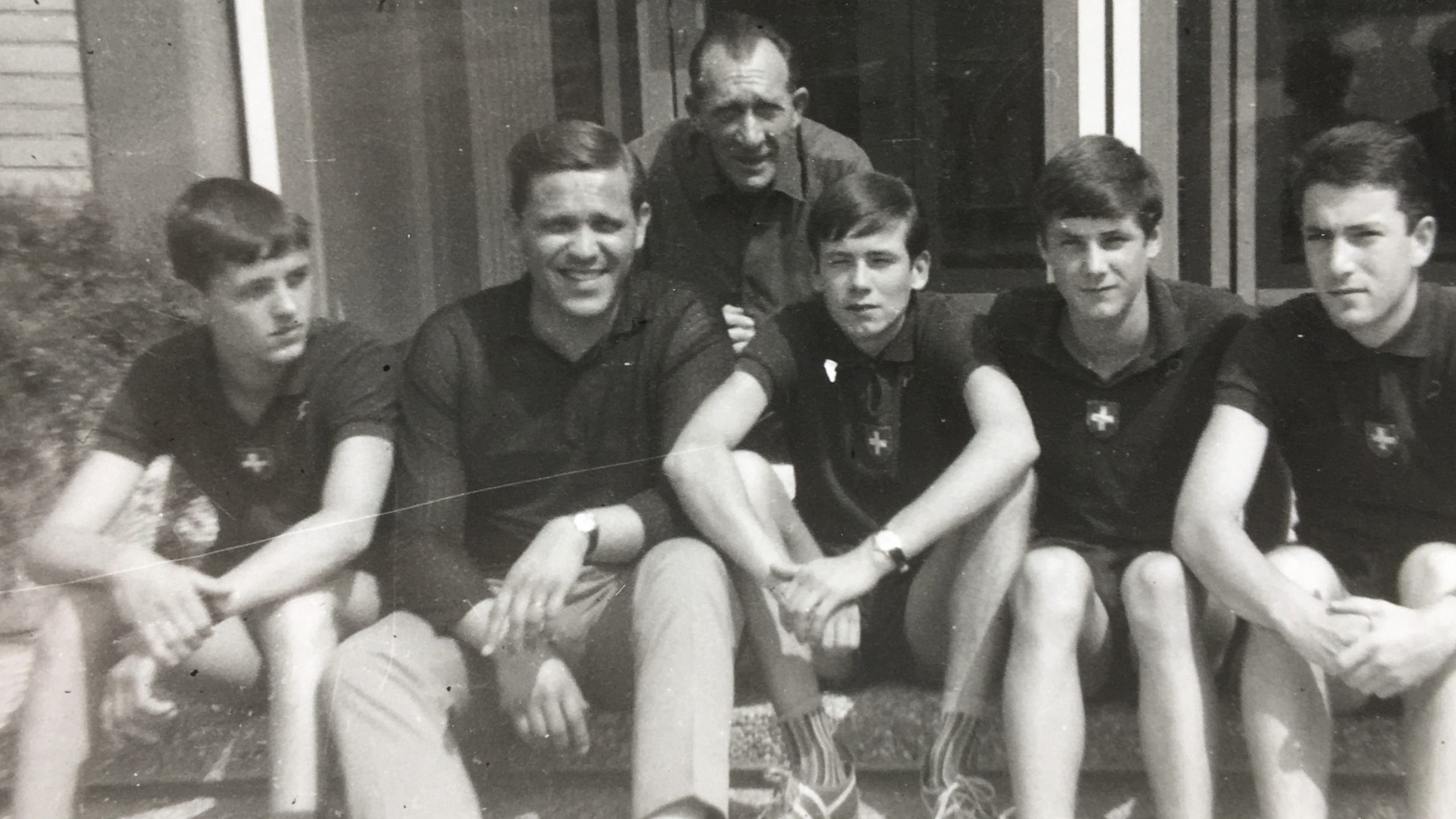
The year is 1963, Laszlo Pal is seated second from left, the coach is Bela Simon (Photo: courtesy of Anton Lehmann)
Contact with table tennis
Always table tennis has always been a popular sport in Hungary, the records of World and European champions speak for themselves.
“There were more good table tennis players than track and field athletes; this prompted me to pick up a table tennis racket now and then, but without competing ambitiously. Nevertheless, I learnt a great deal about this sport and gained insights into the technical requirements to reach a high level.
Also, I also liked to be involved in organisational matters. At 18 years of age, I took over the function of match director in a table tennis club and completed the first coaching level.” Laszlo Pal
Sport was a priority, but education was never forgotten.
“I was aware that I had to plan my professional future, which depended not least on my performance at school. At 18 years old, I successfully completed secondary school with a mathematical-technical focus and enrolled at university to study economics.” Laszlo Pal
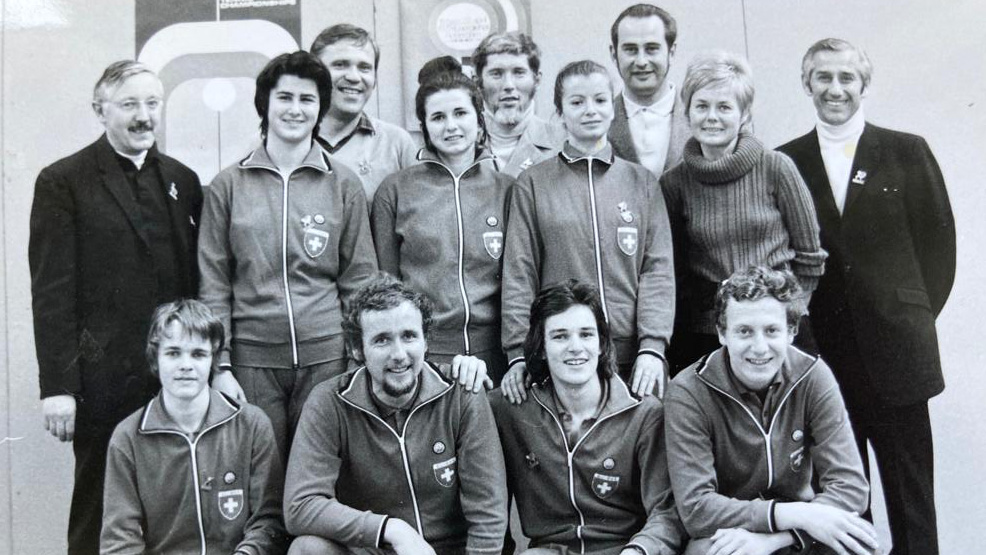
The Swiss team in 1972 (Photo: courtesy of Anton Lehmann)
Hungarian uprising
A place at university but then politics interfered, the Hungarian uprising.
“The people’s uprising began on 23rd October 1956 with a student demonstration for freedom rights. It soon developed into a mass movement that led to the overthrow of the communist government.
At the beginning of November, the Soviets intervened with brutal armed force, deploying tanks, and ensuring that a government which suited them took the helm. At the same time, the insurgent forces were physically eliminated or arrested.
I was just 20 years old at the time, a student of economics, politically inactive and also undecided what to do in view of the dramatic situation. At the university, I had previously completed the basic military course that all students had to take. During the Soviet intervention, I stayed at home for my own protection and out of fear. The fighting in my neighbourhood was particularly fierce.
Finally, I went to the university, where my military superior advised me not to interfere. He was on the side of the uprising, but no longer believed in victory. The decision to flee, however, had mainly to do with my girlfriend Erzi Kala, I was newly in love! Her brother Sanyi Kala had deserted and gone into hiding. He would certainly not have survived if arrested.
I was able to make myself useful as an organiser during the escape. Five of us drove in a van towards the Austrian border. We had to cover the last 20 kilometres on foot.
On 17th November 1956 the border to Burgenland was already closed, but not yet barricaded with barbed wire. In the border town of Neusiedl am See, we were accommodated in a gymnasium prepared for refugees, my meagre knowledge of German proved helpful for communication.” Laszlo Pal
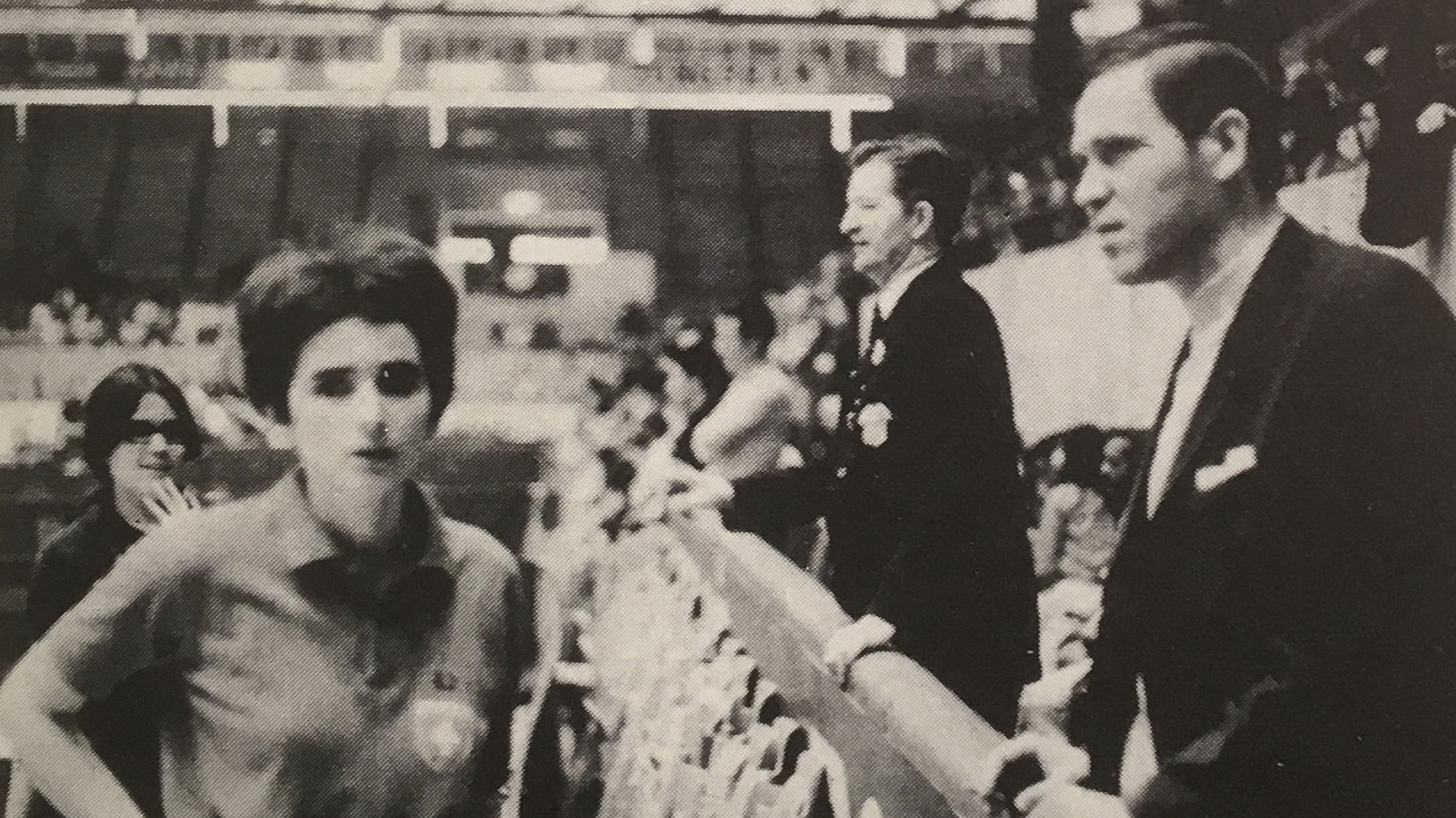 Coaching Vreni Lehmann in 1980 (Photo: courtesy of Anton Lehmann)
Coaching Vreni Lehmann in 1980 (Photo: courtesy of Anton Lehmann)
Switzerland
In Switzerland, the sympathy for the rebellious Hungarians was enormous.
A freedom-loving people heroically opposing the communist Goliath touched the Swiss popular soul deeply.
On 20th November, a nationwide solidarity demonstration took place. Great anger was unleashed against the Soviet Union and communism in general. In sport, Switzerland boycotted the Olympic Games in Melbourne, which began on 22nd November 1956.
“After about a week, a delegation from the Swiss Red Cross contacted us. We were questioned and they wanted to know if we wanted to come with them to Switzerland. We wanted to!
Everything went quickly. We were recognised as refugees in Switzerland almost without any formalities. On 1st December 1956, we moved into the barracks in Sion in the Valais, where I met the decathlete René Zryd.
He was officially looking after the Hungarian refugees. My running stamina must have impressed him, at least he informed his athletics colleagues in Bern.
Soon we moved to Bern and got in touch with TV Länggasse, where teacher Fritz Fankhauser took the lead in supporting us. Apart from sporting matters, the doors were open for me as a track and field athlete and for Erzsi as a basketball player. She had been in the Hungarian national team before fleeing. He arranged a simple two-room flat for us and a job for me at Von Roll cable cars. We got married on 8th January 1957. The marriage, which lasted until the end of the 1970s, produced two children, Andi and Susi.
My active time as an athlete lasted another two years. The limiting factor was the continuous weight gain, Erzsi’s excellent cooking had a visible effect, so I switched to being a member of the coaching staff at TV Länggasse.
On the sidelines, I also had to deal with the young Edy Hubacher. In my opinion, a potential world-class decathlete, unfortunately for the pole vault, he proved unsuitable.” Laszlo Pal
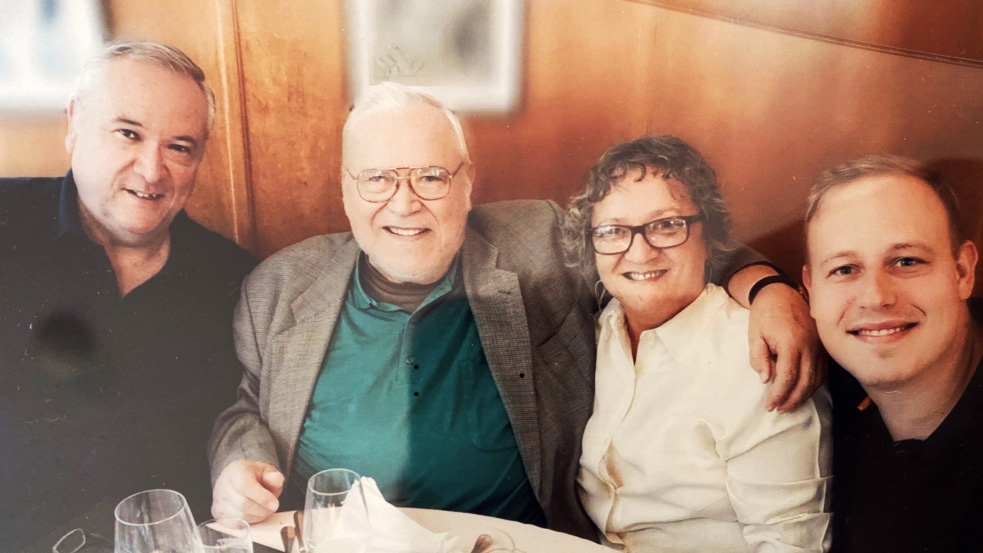
Laszlo with family members Andy, Suzy and Kornel (Photo: courtesy of Anton Lehmann)
TTC Elite Bern
Soon after arriving in Bern, Pal was looking for a table tennis club and came across Max Müller, who played for TTC Elite Bern.
“After a few training sessions, I got myself licensed and proved quite successful at my first tournament in Balsthal, at the beginning of March 1957.” Laszlo Pal
Things really took off when father and son Grimm from Thun turned up at training. Marcel Grimm, blessed with a great deal of talent, rose meteorically. As early as 1959, Grimm and Pal won the Swiss Cup. It was the beginning of an impressive table boom in Bern, it led to national dominance of the Bernese in both individual and team competition in the 1960s and 1970s.
Laszlo Pal made a not insignificant contribution. The best horses in the stable for a long time were Marcel Grimm in the men’s competition and Vreni Lehmann in the women’s competition.
In addition, other top players progressed, such as Markus Schmid, Anton and Walter Lehmann, Rolf Grädel, Paul König, Otto Middendorp and Martin Grimm among the men. A few years later, the highly talented Bernard Chatton joined the team and immediately established himself. Steffi Danioth, Fränzi Weibel and Irma Grimm completed the women’s team.
“I was obviously a reliable supervisor and coach for all these promising players. Not quite conventionally authoritarian, but rather as a sparring partner, advisor, coach, companion at national and international competitions as well as organiser of training camps such as in Magglingen and also abroad.” Laszlo Pal
Both Marcel Grimm and Vreni Lehmann advised that Pal had contributed significantly to their careers. Vreni Lehmann even retroactively promoted Pal to “magician coach”. Bern’s successes did not go unnoticed by national federation officials.
“In 1964, for example, I coached the national team for the first time with the then champions Mario Mariotti, Lajos Antal and Marcel Grimm; from then on I always acted as team manager at World and European Championships. I only had to take a break in Prague and Moscow because, as an exiled Hungarian, I didn’t get an entry visa.” Laszlo Pal

Vreni Lorenzini-Lehmann, Irma Grimm, Laszlo Pal and Marcel Grimm in the early 2000s (Photo: courtesy of Anton Lehmann)
Professional and private career
Arriving in Switzerland, Pal took a job at Von Roll cable cars in Bern: a job with technical challenges. He has fond memories of the 1958 World’s Fair (motto “Technology at the service of man-kind”) in Brussels.
An engagement for the company Ing Maurer AG, ensued which took him, together with his wife and children, to Baghdad in Iraq, for two years. Next he moved to the pharmaceutical multinational Roche before in 1970 representing the company in Japan.
In Japan he made contact with such notables as Ogimura, Tanaka and Tamasu. Also, he attended World Championships as the Swiss coach. Later, from 1975, for a good 20 years, he worked for the industrial group Holderbank; today known as LafargeHolcim.
One year earlier in 1974, Pal became a Swiss citizen, which made his assignments abroad much easier from an administrative point of view. Last but not least, his naturalisation gave him access to his old home country, Hungary, and thus to relatives and friends.
Pal emphasised that he did not take any language courses in the countries of assignment.
“I’m not very gifted in languages anyway, and I was able to get by with English in each case.”
He was proud to mention that he held eight different driver’s licences in those years. In total from 1975: he completed six years work assignments in Saudi Arabia, four years in Libya, two more years in Iraq, one year in the Emirates, one year in Cyprus and, last but not least, eight years in Hungary.
The lifestyle had an effect.
He spent the last part of his working life in Budapest together with his second wife Susy and their son Kornel.
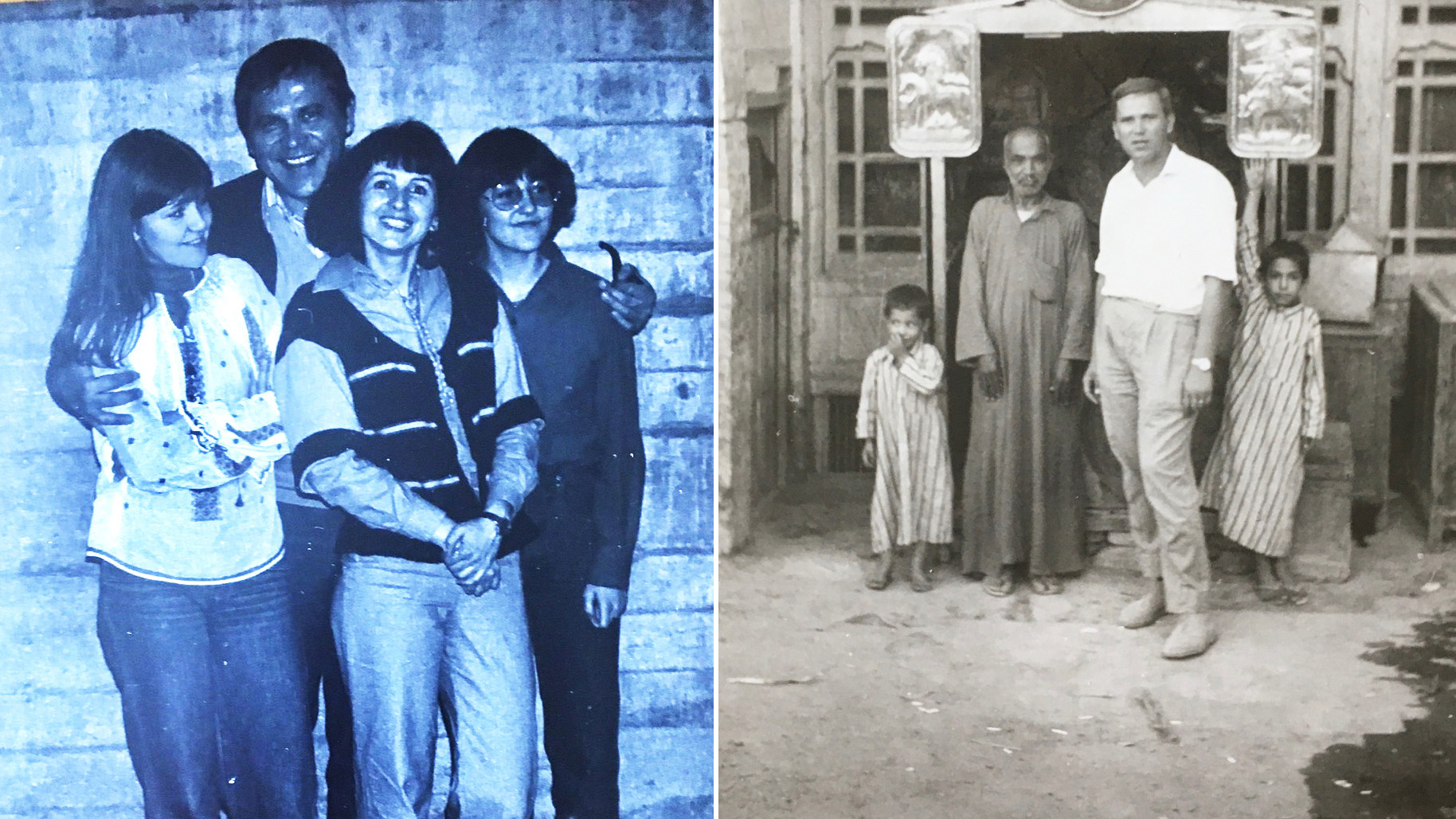 Laszlo Pal with Steffi Danioth, Vreni Lehmann und Fränzi Weibel (right) living in Iraq (Photo: courtesy of Anton Lehmann)
Laszlo Pal with Steffi Danioth, Vreni Lehmann und Fränzi Weibel (right) living in Iraq (Photo: courtesy of Anton Lehmann)
Integration
After the revolt had been crushed by the Soviets, in 1956 around 200,000 Hungarians fled, notably 14,000 found a new home in Switzerland, where they were welcomed with much goodwill, not least because they had opposed the communist regime.
Additional to protection, the Hungarians hoped that Switzerland would improve their standard of living. The conditions impressed displaced persons: for example, the prevailing prosperity, the direct democracy, the modernity of the cities, the public safety.
However, many Hungarian refugees soon realised that prosperity does not come automatically or for free. They had to work hard for it, not all of them succeeded.
The Pal couple were among those who were able to integrate quickly, mainly because of their affinity for sport, their competence in this field and their commitment. The sporting network was a strong integration factor. Sport proved to be a perfect door opener and bridge builder between different areas of life.
The Hungarian immigrants formed political, cultural and sporting associations. Laszlo Pal also moved in these networks. A Hungarian table tennis network emerged, in which Pal played a central role; this network was characterised by close ties with Hungary, which was a major table tennis power.
For decades, Hungarians such as Victor Barna, Ferenc Sido, Eva Koczian, Agnes Simon, Zoltan Berczik, Istvan Jonyer, Gabor Gergely and Tibor Klampar had dominated the European scene. They had challenged the world’s elite.
Resulting from this dominance, the immigrant Hungarians enjoyed an almost automatic bonus in Switzerland, they were table tennis experts par excellence. In Switzerland, the most well-known Hungarians were first Lajos Antal, later Laszlo Pal and finally the couple Laszlo and Theresia Földy. In their wake, less prominent players and coaches named Csernay, Olaszy, Viragh, Nemeth, Kiraly, Horvath, Elekes also excelled.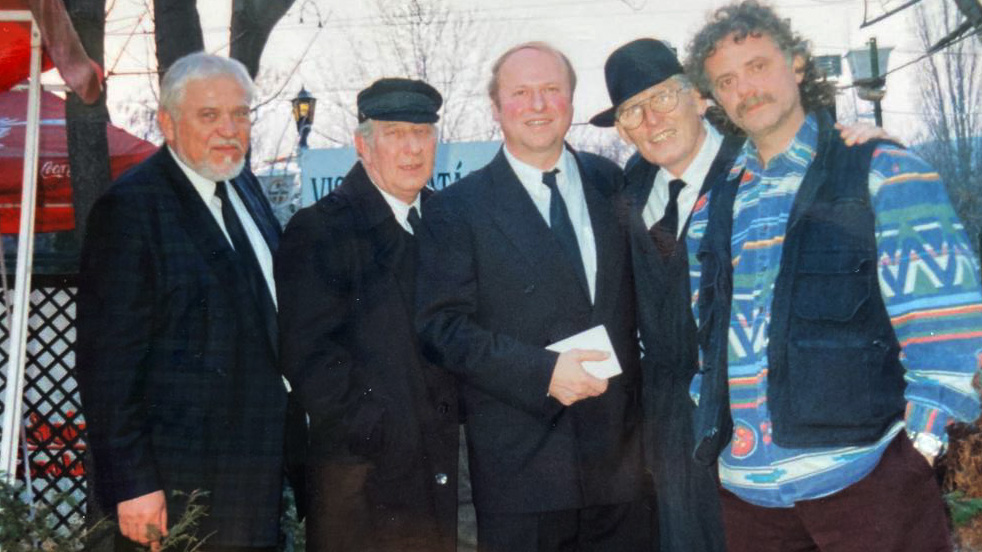
Laszlo Pal in 1998 with Zoltan Berczik, Istvan Jonyer, Laszlo Földy and Gabor Gergely (Photo: courtesy of Anton Lehmann)
Interest in politics
One measure of integration is, among other things, is the participation in social and political life in the new homeland.
Laszlo Pal has always displayed great interest in the domestic and foreign policy issues discussed in Switzerland. He was on the side of the bourgeois majority, both in elections and in votes. During our discussions, his table tennis pupil, who held radical left-wing positions, there were frequent disagreements.
Nevertheless, our good relationship remained intact. The friendly relationship based on sporting common ground was stronger than the ideological differences. Every now and then we asked each other, with a wink, which of us was the better Swiss!
The friendly relationship based on sporting common ground was stronger than the ideological differences. Every now and then we asked each other, with a wink, which of us was the better Swiss.
Without complaining of homesickness, Pal remained rooted in both cultures and languages throughout his life; his Hungarian origins were clearly reflected in Pal’s family history and his circle of friends. After his naturalisation in 1974, he enjoyed “free movement of persons” between Switzerland and Hungary.
The long-standing friendship of the two Laszlos, Pal and Földy goes back to their first table tennis contacts in Budapest. Földy was one of the well-known Hungarian players at that time. In contrast to Pal, Földy stayed in Hungary until the mid-1960s.
After working as a coach in Iran and Greece for some time, he came to Switzerland in 1969. He and his wife Theresia successfully continued their table tennis career and remained friends with Laszlo Pal and his family for decades. Wives who were friends ensured stable relationships.
From afar, Pal has always followed with interest the political developments in his first homeland, Hungary, from “goulash communism” to the bankruptcy of the Eastern European version of communism in 1989.
Later, in recent years, Pal rather sympathised with the strengthened nationalists in Hungary who dreamt of the long-gone Greater Hungary.
Thus, he supported the domestic political development under the authoritarian leadership of head of state Orban and his Fidesz party. It is well known that rising nationalism in Hungary, Poland and elsewhere is highly controversial within European states and probably also causes heated debates in the Hungarian Swiss diaspora.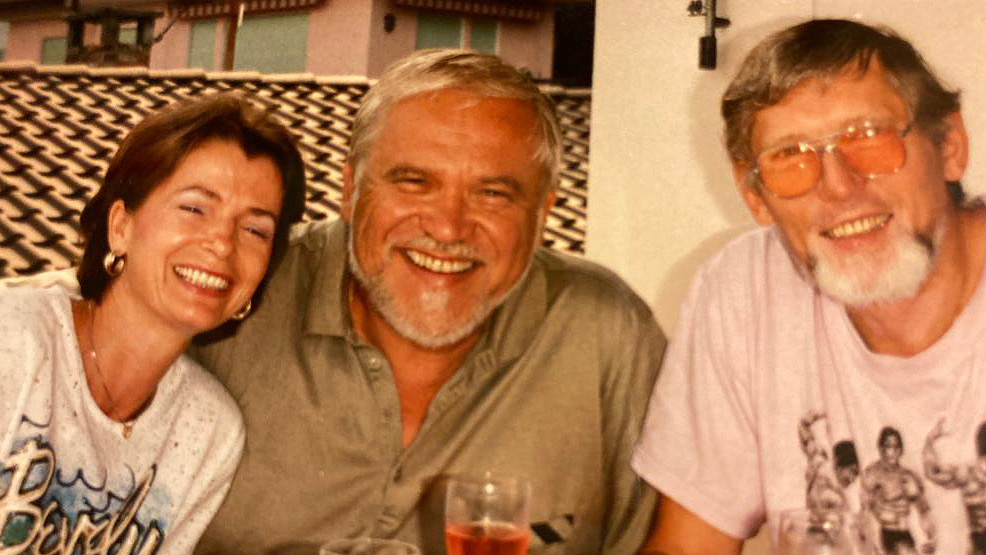 Theresia Földy with Laszlo Pal and Laslo Földy (Photo: courtesy of Anton Lehmann)
Theresia Földy with Laszlo Pal and Laslo Földy (Photo: courtesy of Anton Lehmann)
Relections
Looking back, I don’t want to claim that Laszlo Pal was a womanizer, but it was not only me who noticed that many women liked him.
An easy going attitude towards women impressed us youngsters who were just beginning to discover the opposite sex. When asked later about his dealings with women, he said laconically that they appreciated his knowledge of people and the world.
He himself was surprised that he was given the label of a womaniser. I still have fond memories of how, at an international youth tournament, he brought me into contact with a German player whom I obviously liked “as if by chance”, which led to a harmless youth love affair that lasted for some time.
Ditto at the 1965 World Table Tennis Championships in Ljubljana (I was 19 at the time), where I made the acquaintance of a lovely Hungarian player who didn’t speak a word of German; we got on extremely well with Laci’s support.
Swear words
Hungarians, especially men, often swear like a buffoon when they think they are not being watched.
They have a large colloquial vocabulary of expletives at their disposal: from today’s point of view, this is a misogynistic orgy of curses and swear words, which, similar to English “four letter words”, use vulgar, macho language or make light of taboo sexual practices.
Especially in table tennis training, avoidable mistakes, unforced errors were commented on with swearing. So often, in fact, that we young people essentially learnt to swear in this difficult language.
After repeated insistence, we were finally provided with translations that do not belong on a sheet of paper.
Memorably, in 1968, during my stay in England, I was accepted as a table tennis practice partner in a top London club where I also completed the English coaches programme.
Once I was discreetly taken aside by a fellow player. The question as to whether I was Hungarian astonished me only for a brief moment; that is, until he pointed to an older player of Hungarian origin who was shocked by my lewd language.
Punctuality
As a commercial apprentice, I cycled to my place of work twice a day, which meant a good hour’s journey. My boss, who was relatively sport friendly at the time, allowed me to leave the workplace half an hour earlier if I had an important table tennis match coming up.
Laszlo Pal offered to pick me up to save time and to avoid wasting too much energy on the bike. He showed up but was usually late or just barely on time.
“Yes, that was a weakness of mine at the time, not keeping to Swiss punctuality.” Laszlo Pal
Unfortunately, my boss noticed that I often waited a long time for my coach. The conclusion: I was only allowed to leave the workplace when Laszlo had arrived, which meant that my half hour practice often melted away.
What remains when Laci is missing?
In recent years we have had to say goodbye to numerous members of the Swaythling Club: Vera Bazzi, Laszlo Földy, Claude Duvernay, Christiane André, Mario Mariotti, Bernard Chatton, Marie-Jeanne Urchetti, Werner and Yvonne Schnyder; now also Laszlo Pal.
Anyone who had a good relationship with the deceased will agree that all of them were somehow unique in their own way. We not only remember sporting careers but also certain characteristics, valuable encounters, shared experiences.
It is interesting that we automatically associate someone with a very special ping-pong-specific feature that we have stored in our visual memory: a striking gesture, a rare pattern of movement, a tactical move, a grandiose recovery, a lead wasted.
For example, Mario Mariotti’s cool way of using his unconventional forehand smash that wouldn’t fit into any table tennis textbook, or Bernard Chatton’s multisport talent.
Finally, Laszlo Pal’s coaching interventions also belong to the category of formative features.
Some players still get carried away when they think back, “for me he was a magician”, others report states of anxiety because they were on the opposite side. They had to fight against Pal as well. Once, it is rumoured, Pal was even given a red card for excessive coaching.
“Movement is life,” Pal lectured during our last meeting at his home, when I asked him about his reduced quality of life in terms of mobility and autonomy. The astonishing answer of a man who had enjoyed sports all his life was something like this: movement should not only be understood physically.
He kept himself mentally fit by continuing to follow current affairs, reading a lot and watching current affairs programmes. Social life consisted of looking forward to visits and spending a lot of time on the phone with friends and old acquaintances.
It was also important to come to terms with his existence, which was characterised by age-related limitations. He was glad that he could gratefully accept help and care, even if he only partially expressed this in his ordinary everyday life, Pal said self-critically.
The insightful conversation with Laszlo made one thing clear; Pal had a phenomenal memory. He was a walking encyclopedia and not only in terms of sports reporting; an encyclopedia that unfortunately can no longer be consulted.
Revisiting elements of our shared past, it became clear that Laszlo Pal had more often stored details of my own table history more precisely than myself.
We had to, indeed wanted to, toast to this once again. A glass of red wine was not to be missed.
Now no more, good bye Laci.
